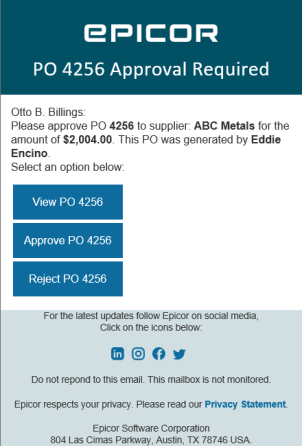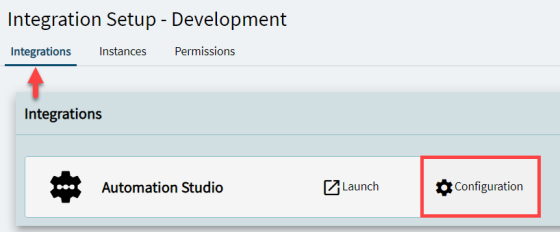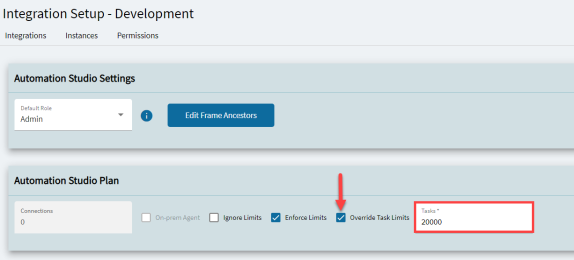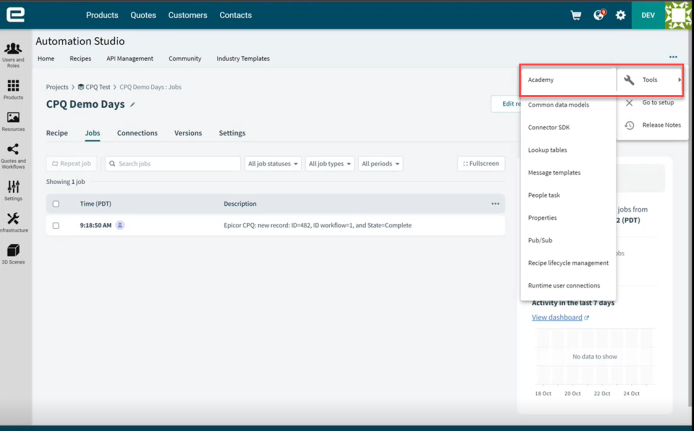
Epicor Automation Studio, powered by Workato®, connects your platform with external cloud-based tools that help you automate business workflows across cloud and on-premises applications. This enterprise-grade workflow automation platform enables both business and IT users to efficiently build workflow automation. It can handle problems like integrating applications and data. Automation Studio is designed for security, robustness, reliability, and high performance.
By connecting with these external tools, you design processes, or recipes. These recipes run automatically and handle a task or a series of tasks. Create as many complex or simple recipes as you need. One recipe can automate data between multiple connections, but at least one of these connections must be with your platform.
Each recipe has one or more tasks that you define. Connect these tasks in a workflow that generates the actions you want. Then set up triggers that run each task. The triggers activate automatically through changes from your platform, a cloud-based tool, or a scheduled event. The tasks cause actions to run, such as adding or updating a record.
By creating automated recipes, you make sure data across your organization is up-to-date and reflects current business activity. While you create a trigger, Automation Studio accesses the database tables potentially affected by the task. Once you select a table from this list, Automation Studio then shows the fields inside this table. Select the fields you wish to update in the database.
This is an optional feature; it is not part of the baseline system. You cannot access any of the functionality described here without first purchasing this additional package.
During this article, we explore:
You purchase access to Automation Studio in two ways. Larger organizations will likely buy connections. Each connection links your Epicor ERP product to an external cloud-based tool. Purchase a connection for each external tool you will link to your Epicor product. Smaller organizations will likely purchase tasks. Through this option, you purchase task bundles, such as a 90,000 task bundle. This task bundle is large enough to process 10 sales orders per day with 25 tasks per order for an entire year. Purchase the connections or task bundles that reflect how much you estimate you will use Automation Studio.
Through either purchase option, you may reach a task limit. Automation Studio sends you a warning as you approach this limit. You can then buy more tasks or connections as you need.
Next you integrate your Epicor product with Automation Studio. Do this through the Integration Portal. To help you step through the integration process, review "Integrating Automation Studio with Eclipse." Automation Studio connects with your Epicor product through HTTPS.
If you run an on-premise environment and want to use Automation Studio with applications in this environment, you need to do additional setup. Connect Automation Studio with your on-premise environment in two ways.
One way is that you can grant Automation Studio secure access to on-premises applications through your firewall. This prevents malicious access to your database traffic. Do this by adding IP addresses to an IP Allowlist. Through this method, Automation Studio can access your applications by configuring your firewall to allow specific IP addresses and making each API publicly accessible. This setup requires adding the necessary IP addresses to this IP allowlist; contact your System Administrator for help setting up this list.
Learn more about creating an IP Allowlist by going to the Workato documentation and reviewing this help article:
IP allowlists - https://docs.workato.com/security/ip-allowlists.html
The second way is you can purchase an On Premises Agent, or OPA from Epicor. The OPA grants Automation Studio selective access to authorized on-premises applications. When you use this method, you also need to add the necessary IP addresses to an IP allowlist, but it DOES NOT require public API access through your firewall. Your REST APIs can then stay restricted within your network. You configure the OPA to securely connect Automation Studio to your server. Each server you use with Automation Studio will need its own OPA.
Learn more about installing and managing an OPA by going to the Workato documentation and reviewing these help articles:
Accessing On-prem - https://docs.workato.com/on-prem.html#overview
On-prem Agent - https://docs.workato.com/on-prem/agents.html#on-prem-agent
Be aware that an OPA is not a connector. You still need to create connectors for each on-premise application that you will integrate with Automation Studio.
Once you have set up either the IP Allowlist or the On-Premises Agent (OPA), your on-premise application can then communicate with Automation Studio.
You can create low-code or no-code workflows using recipes. Every automation workflow is a recipe. Recipes are the building blocks of any automation workflow. They can span multiple applications. A recipe is usually made up of one trigger, one or more actions, and connections. A recipe starts with a trigger, and consists of several actions that it performs after it is triggered. The actions can be of various types:
It can be an action performed in an application.
It can be an IF condition that is satisfied.
It can be an IF//ELSE condition that is verified.
It can be a repeat action that is performed for some set of items.
It can call another recipe.
It can stop a job and/or handle errors.
Recipes can be classified based on the kind of trigger they use:
Time-based triggered: You can schedule it minutely, hourly, daily, for a day of the week, etc.
Application triggered: These recipes are based on the connector logic.
Webhook triggered: These recipes use webhooks as triggers.
Functions: These recipes can be called from other recipes.
API recipes: API callable from other systems, like, BPMs, functions, etc.
The components of a recipe are:
Connections: When you start building a recipe, the first step is establishing a connection between Automation Studio and an application. This application contains a function that interacts with your platform. Each connection is associated with one instance of the app and can be re-used across recipes. For example, a connection can be made with a user account.
Triggers: Triggers determine what event listens to execute the actions described in a recipe. They set off, or launch, when a certain event happens or according to a schedule.
Steps: Recipe steps are actions or control flow statements that help you describe business logic. Different kinds of steps are:
Action Step: Actions carry out an operation in your target app, such as a create, update, or search operation. Each action requires a set of input fields and typically returns data as output data tree.
Conditional Step: Conditional steps carry out an If-ELSE decision in the workflow. An IF condition step directs a recipe to run an action or set of actions if the specified condition is met.
Repeat Step: Repeat steps are a set of actions that carry out on a set of items. Use them when working with an item list, such as a list of invoice line items. Actions indented within a repeat block are carried out for all items in the list. A repeat step uses output from the repeat step's datatree to ensure that all item in the list are processed.
Datapills are output data from a trigger or an action step. You can use datapills as variables to map business logic into recipe steps.
In every recipe step, you have access to datapills from all the previous steps. Use them to configure the input fields for the current step.
Datapills are contained in App Data section in the Datatree. At any step of the recipe, the App Data section contains the output from the trigger and every action preceding this step.
You can also assign datapills or constants as input fields to a trigger or an action step. This Field Mapping controls the flow of data between the apps.
You can look at the following example to understand how you can use Automation Studio to run your business efficiently.
You build a recipe that handles purchase order approvals. A buyer creates a PO within your platform. This triggers an email that Automation Studio sends to the purchase manager. The purchase manager uses this email to view, approve, or reject the PO.
Saving an unapproved PO launches a trigger on the recipe. This trigger activates a task, and the task action sends the PO email notification to the manager. The email contains three triggers that launch three task actions. One trigger displays the PO, another approves the PO, and the third trigger rejects the PO:

Depending on what the purchase manager selects, Automation Studio runs the view PO, approve PO, or reject PO task. The resulting action causes another task to run on the record, and the buyer sees the approve or reject PO outcome.
When you run an Automation Studio recipe, it consumes tasks. You typically purchase task bundles from Workato. Sometimes a recipe you are developing in a non-production environment, such as a Sandbox or Test environment, can consume more tasks then you intend. This often happens if a new recipe accidentally processes in a loop. These wasted tasks are an unnecessary expense.
To prevent recipes from consuming too many tasks, non-production environments have a maximum of 10,000 tasks available to consume each month. As the environment gets closer to this monthly limit, you receive alert emails. The first email alerts you when it has used 50-75% of its available monthly tasks. The second email alerts you when the environment consumes 75-99% of the tasks, and the last email alerts you when it reaches the 100% limit. Now if a recipe attempts to run, you receive one final warning email that this environment is over the limit. After this, Automation Studio will stop and you can no longer run recipes in this non-production environment.
Global Administrators can increase or decrease this monthly limit as needed. They make this change on the Integration Portal:
Launch Integration Portal and go to the page for the non-production environment.
Select the Integrations tab.
Select the Configuration button.
Go to the Automation Studio Plan section. Select the Override Task Limits check box.
Go to the Tasks field and enter the new limit.
Save the configuration.
If the Global Administrator added more tasks to the monthly limit, Automation Studio will resume and you can run recipes in this non-production environment again.
Workato has an extensive documentation site that can help answer your questions. Explore the Workato Docs site to see information on Recipe Design, Connectors, Data and Security, and other key categories. Use the search field to locate the information you need. This site also connects you with update information about Automation Studio.
To launch this site, go to: Workato Docs (https://docs.workato.com/)
The Workato Digital Academy contains multiple courses which will help you fully leverage Automation Studio within your business environment. Be sure to take several courses to maximize your investment in Automation Studio. You can access the Academy directly through the Workato website or through the Eclipse Automation Studio product window.
To access from Workato Website:
Log with your account credentials.
Go to System Management > Integrations > Automation Studio.
To access from Automation Studio:
Select the Overflow menu and the Tools sub-menu.
Select the Academy option.

It is recommended that consultants and engineers take the courses up to at least the intermediate level or more. Some recommended courses are: